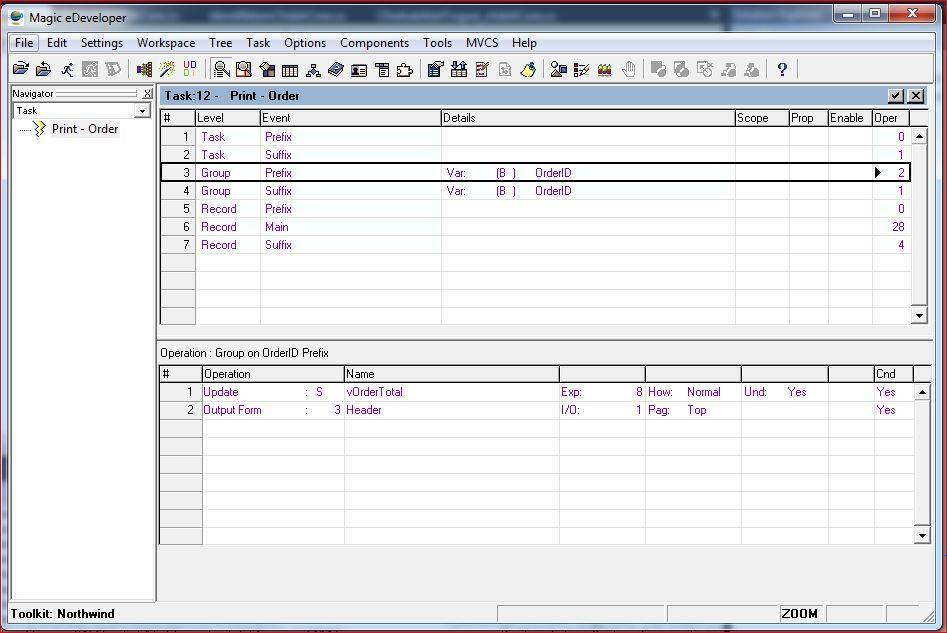Introduction
This article is one of a series of articles aimed at providing further orientation with the migrated code for Magic programmers. This time we will look at the different States as they appear in eDeveloper (version 9) and show the equivalent representation of each setting in the migrated code.
We will discuss Online and Batch task types. Both share common states and each also has unique states of its own. The following table shows the syntax in .Net for each magic state.
| Magic Name | Migrated Code Name | Occurs in |
|---|---|---|
| Properties | OnLoad | UIController, BusinessProcess |
| TaskPrefix | OnStart | UIController, BusinessProcess |
| TaskSuffix | OnEnd | UIController, BusinessProcess |
| RecordPrefix | OnEnterRow | UIController, BusinessProcess |
| RecordSuffix | OnSavingRow | UIController, BusinessProcess |
| OnLeaveRow | BusinessProcess only | |
| GroupPrefix | delegate call | BusinessProcess only |
| GroupSuffix | delegate call | BusinessProcess only |
| Control Prefix | .Net Event | UIController only |
| Control Suffix | .Net Event | UIController only |
| Control Verification | .Net Event | UIController only |
| Control Change | .Net Event | UIController only |
| Handler | .Net Method | UIController, BusinessProcess |
Online States
Let's first look at an example of a screen displaying different Online states:

Load Properties
This refers to all properties that appear in screens such as Ctrl+P (Task Properties), Ctrl+C (Task Control), Ctrl+I (Media Properties), etc.
Name in Migrated Code: OnLoad Method
Example:
protected override void OnLoad()
{
AllowSelect = true;
Activity = Activities.Browse;
} Task Prefix
Name in Migrated Code: OnStart Method
Example:
protected override void OnStart()
{
v_myNumberColumnField.Value = 0;
u.DBDel(typeof(Model.myFileName), "");
} Task Suffix
Name in Migrated Code: OnEnd Method
Example:
protected override void OnEnd()
{
_taskresult = vMyValue;
new ClosingMethod().Run();
} Record Prefix
Name in Migrated Code: OnEnterRow Method
Example:
protected override void OnEnterRow()
{
new MethodtoRUnBeforeEachEachRow().Run();
} Record Suffix
Name in Migrated Code: OnSavingRow Method
Record Main
Name in Migrated Code: Constructor and Run Method
Example:
/// <summary>ShowProducts(P#10)</summary>
public ShowProducts()
{
Title = "ShowProducts";
InitializeDataViewAndUserFlow();
}
void InitializeDataViewAndUserFlow()
{
From = Products;
OrderBy.Add(Products.ProductName);
OrderBy.Add(Products.UnitPrice, SortDirection.Descending);
// parameter for selection task
Columns.Add(pi_ProdID);
Columns.Add(Products.ProductID);
Columns.Add(Products.ProductName);
Columns.Add(Products.UnitPrice);
Columns.Add(stam);
}
/// <summary>Run</summary>
/// <param name="ppi_ProdID">pi.Prod ID</param>
public void Run(NumberParameter ppi_ProdID)
{
BindParameter(pi_ProdID, ppi_ProdID);
Execute();
} Controls
Name in Migrated Code: User Defined Method
Location in Migrated code: Controls handlers section, (after the Expressions section)
Controls obviously appear only in UIController code and can have the following four states:
Control Prefix
Methods of this type in the migrated code have names ending with _Enter
Example:
#region Controls handlers
internal void txtCustomers_CustomerID_Enter()
{
//code
}
#endregion Control Suffix
Methods of this type in the migrated code have names ending with _Leave
Example:
#region Controls handlers
internal void txtCustomers_CustomerID_Leave()
{
//code
}
#endregion Control Verification
Methods of this type in the migrated code have names ending with _InputValidation
Example:
#region Controls handlers
internal void txtCustomers_CustomerID_InputValidation()
{
//code
}
#endregion Control Change
Methods of this type in the migrated code have names ending with _Change
Example:
#region Controls handlers
internal void txtCustomers_CustomerID_Change()
{
//code
}
#endregion Batch States
Now let's look at an example of a screen displaying different Batch states.

Most of these states are the same as the Online ones, with the exception of the following:
Record Suffix
Name in Migrated Code: OnLeaveRow, OnSavingRow Methods
OnLeaveRow() occurs after leaving every record as opposed to OnSavingRow() which occurs only when data from the record needs to be saved to the Database. Thus, for a record that needs to also be saved to the database, both OnLeaveRow and OnSavingRow events will occur.
Example: OnLeaveRow:
protected override void OnLeaveRow()
{
_layout.Body.WriteTo(_ioPrint_Order);
if(false)
{
StartRun("dir", false, System.Diagnostics.ProcessWindowStyle.Normal);
}
new ENV.Utilities.FileViewer("c:\\temp\\test.txt",new UI.Print_Orders_Browse(this)).Edit();
} Groups
Name in Migrated Code: Groups.Add() Method Location in Migrated code: constructor
GroupPrefix
Groups.Add defines the grouping for the selected variables, while groupname.Enter and groupname.Leave represent the GroupPrefix and the GroupSuffix respectively.
Example: First lets look at usage of Groups.Add in the Constructor:
public Print_Orders()
{
Title = "Print - Orders";
InitializeDataView();
_layout = new Printing.Print_Orders_Layout(this);
var Orders_CustomerIDGroup = Groups.Add(Orders.CustomerID);
Orders_CustomerIDGroup.Enter += Orders_CustomerIDGroup_Enter;
Orders_CustomerIDGroup.Leave += Orders_CustomerIDGroup_Enter;
} GroupSuffix
Next, lets look at the delegate method call for the Group Prefix, using Group.Enter:
void Orders_CustomerIDGroup_Enter()
{
_layout.CustomerGroupHeader.WriteTo(_ioPrint_Order);
} Finally, lets look at the delegate method call for the Group Suffix, using Group.Leave:
void Orders_CustomerIDGroup_Leave()
{
_layout.CustomerGroupFooter.WriteTo(_ioPrint_Order);
} Help us improve, Edit this page on GitHub
or email us at info@fireflymigration.com
